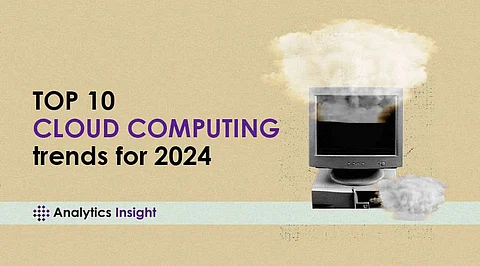
- Insights
- Cryptocurrencies
- Stocks
- White Papers
- Industry
- Geography
- Insights
- Cryptocurrencies
- Stocks
- White Papers
- Industry
- Geography


Cloud computing adoption fuels several revolutionary tech developments, such as AI and IoT. Businesses will continue to employ cloud services to gain access to new technology in 2024. These trends will also allow them to drive operational and process efficiency.
1. Edge Computing: Edge Computing stores and processes data at the network's edge. It reduces latency and bandwidth needs by allowing quicker and more efficient data processing. It provides strong privacy, fast data transfer, and greater efficiency. Moreover, edge computing will be crucial to the cloud approach.
2. Multi and Hybrid Cloud Solutions: Multi-cloud and hybrid cloud systems combine on-premise, private, and public clouds. Companies may distribute their workload among many cloud providers and on-premises frameworks. This allows them to keep control over the data and apps.
3. Cloud Security and Resilience: Security and resilience have become critical issues as organizations migrate to the cloud. As a result, cloud providers are increasing their investments in security and resilience. Data encryption, access restrictions, and disaster recovery are among the features. Increased cloud use and investment will aid in data safety.
4. Blockchain: Blockchain technology is a type of distributed ledger. It works in tandem with cloud computing to develop new apps and services. Blockchain can safely and efficiently process massive volumes of data and exert control over documents. The technique has a lot of promise for industrial applications. It provides dependable security, transparency, and decentralization.
5. Internet of Things (IoT): The Internet of Things (IoT) is expanding, necessitating investment in the technology by cloud providers. It maintains links between computers, servers, and networks—the Internet of Things is a middleman. The Internet of Things also assures a successful connection and aids in data collection from faraway devices. It enables enterprises to manage and analyze massive amounts of data generated by IoT devices.
6. Kubernetes and Docker: Kubernetes is a container orchestration platform that is open source. It automates the deployment, scaling, and administration of containerized applications. Kubernetes and Docker have the potential to revolutionize the way organizations handle cloud installations. These technologies help businesses to efficiently launch and scale applications. Docker is also a containerization platform. It gives developers the ability to bundle their apps into containers.
7. Artificial Intelligence (AI) and Machine Learning (ML): AI and machine learning are strongly tied to cloud computing and affordable. These systems manage massive amounts of data and increase the company's output. Increased automation and self-learning ability are two more AI and ML developments anticipated to arise. Data gathering and algorithm training need computing and storage resources.
8. Automation: Cloud computing relies heavily on automation. It improves the efficiency of the business and the system and network quality. Automation also decreases the possibility of sluggish or downtime systems. Yet, deploying automation is difficult. Thanks to increased investments, citizen developer tools, and AI, more devices are being developed to make automation more pleasant for cloud suppliers.
9. Citizen Developer: The Citizen Developer idea empowers those who cannot code with the power of linked technology. Several technologies allow novice users to connect APIs and develop customized automation without coding. As we approach 2024, large corporations will introduce many tools with drag-and-drop interfaces to make it easier for developers to create sophisticated programs.
10. More Data Investments: The cloud enables organizations to analyze, collect, and store data. It enables businesses to store data in a more extensive database in a distributed computing environment. Large data volumes will be processed by storing them in graphics processing units (GPUs), greatly parallelizing computation.
